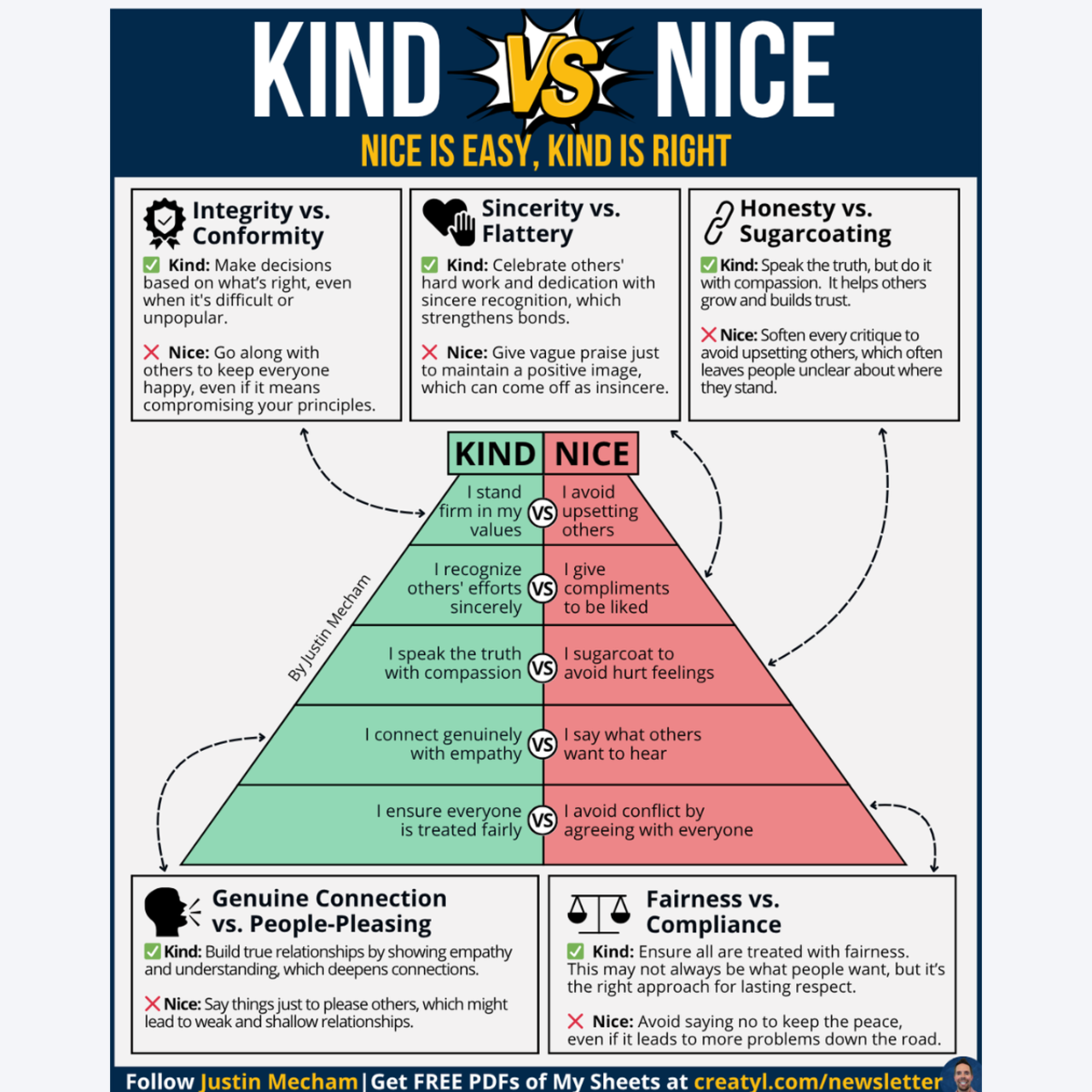To download today's infographic, click here.

The Comfort Trap: Why Niceness Feels Good—Until It Doesn’t
Most workplaces prize “being nice.”
Smiles in every meeting. Soft words in every email. Agreement in every discussion.
It feels smooth—until things break.
Because “nice” is easy. It keeps the peace. But when honesty is required, nice collapses.
Kindness is harder. Kindness tells the truth, helps people grow, and still keeps respect intact.
Kindness isn’t about being harsh. It’s about being honest without being cruel. It’s about clarity that builds trust—not fear.
And it’s exactly what most teams are missing.
Here’s how to stop protecting people from discomfort—and start helping them do their best work.
Nice Delays Progress—Here’s the Cost
Nice avoids conflict, so problems linger. Deadlines slip, but no one speaks up. Bugs grow, but feedback stays polite.
Nice trades clarity for comfort. People leave meetings confused because no one asked the hard question. No one said what needed saying. Work slows down—not from laziness, but from vague direction and hidden tension.
Nice builds shallow trust. Teams bond on good days but scatter when tension rises. When reality hits, the smiles disappear.
If you want results that last, nice won’t cut it. You need kindness.
Kindness sounds like truth. It looks like clarity. It works like trust.
Kind Wins at Every Level: A Pyramid to Remember
Picture a pyramid with “Kind” on the left and “Nice” on the right. Move from the base up:
Fairness vs. Compliance
Kind: “Let’s make this decision fair, even if a few are unhappy.”
Nice: “Let’s agree to avoid pushback, even if it hurts long-term.”
Genuine Connection vs. People-Pleasing
Kind: Ask real questions, listen, and respond.
Nice: Nod, smile, and move on.
Honesty vs. Sugarcoating
Kind: “Your draft misses the mark—here’s why.”
Nice: “Looks great, maybe tighten it a bit?” (Translation: redo everything.)
Sincerity vs. Flattery
Kind: A clear “Thank you for the late night.”
Nice: “Amazing job!” (No detail, no context.)
Integrity vs. Conformity
Kind: Stick to values when pressure comes.
Nice: Bend when the crowd wants comfort.
Move up each layer, and you’ll see why kindness wins: it deals in reality and respect.
Hard Truths, Better Results: A Real Workplace Reset
Problem
A product team kept missing release dates. Everyone praised each other’s effort, but no one named the real block: the design lead was overloaded and silently erasing time from every schedule.
Agitation
Projects piled up. Marketing blamed engineering. Engineering blamed specs. The design lead worked nights, but morale sank. “Niceness” protected feelings and hid facts.
Solution
The team tested a “kind over nice” reset:
- Set the room: One short meeting, camera on, clear agenda: “Name one roadblock we’ve avoided.”
- Tell the truth with care: The design lead shared workload numbers—no blame, just data.
- Ask real questions: “What single change removes the most friction?”
- Give fair next steps: Tasks were cut, deadlines moved, and senior leaders publicly owned the new plan.
- Repeat honesty weekly: A five-minute Friday check-in—one win, one struggle.
Within two sprints, delivery dates leveled, stress surveys fell, and the lead stayed—because the team traded politeness for clear, kind honesty.
New Habits That Build Real Trust
Swap Praise for Proof
Say: “Your research cut dev time by 30%. Thank you.”
Skip: “Great work!” (and nothing else).
Use the Two-Line Truth
Line 1: The reality (“This feature is late.”)
Line 2: The respect (“I know you’ve balanced three tasks—how can we fix this together?”)
Ask Before You Advise
“What feels stuck to you?” opens space; advice lands better after listening.
Name the Value Behind Your ‘No’
“I’m turning this down so I can finish the security audit on time.”
Close Every Meeting With a Fair Check
Round-robin: “Does this feel clear and fair?”—then adjust on the spot.
Fresh Resources for Leading With Courage
Book — Radical Candor by Kim Scott
Learn how to care personally while challenging directly. Scott breaks down how to give honest feedback that strengthens relationships instead of breaking them.
Course — Conscious Leadership Group’s 15 Commitments
A powerful framework that helps leaders shift from control and comfort to clarity and growth. Great for anyone managing teams through real-world pressure.
Podcast — WorkLife with Adam Grant
Grant unpacks workplace behavior with top thinkers and leaders. Expect research-backed takes on what happens when teams prioritize real communication over comfort.
The Most Respectful Thing You Can Do Is Tell the Truth
Ask yourself:
Would your team know how to act if you weren’t in the room? Can they explain the ‘why’ behind what they’re building? Do they know when they’re off-track—without needing a performance review to find out?
If the answers make you pause, that’s the signal.
People don’t disengage because they’re lazy. They disengage because they feel unseen, unheard, and uncertain.
The most underrated leadership move isn’t charisma or efficiency. It’s clarity.
Kindness is clarity, spoken with care. It’s the only way to lead a team that’s strong when things go wrong.
Nice protects feelings in the short term. Kind protects people for the long haul.
And the difference always shows when pressure hits.
Download the Infographic: Use This Sheet With Your Team
Want to keep this visual nearby for fast reminders?
Download the full infographic as a high-quality PDF—perfect for team workshops, feedback sessions, or personal leadership reviews.




